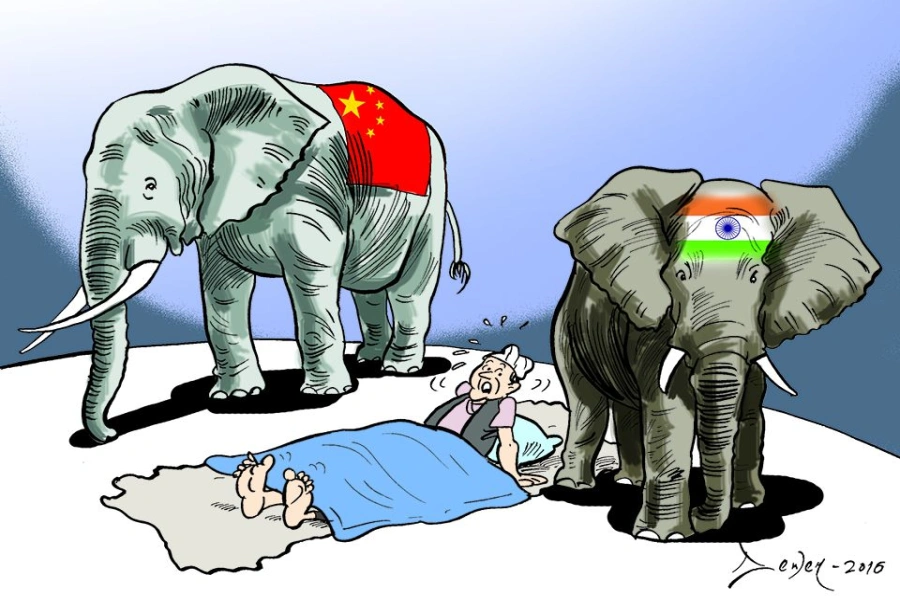Nepal's geographical fate is not merely a footnote in its national narrative but the central theme of its existence. Positioned strategically between the burgeoning giants of China and India, and playing a role in the strategic interests of the United States, Nepal finds itself at the crossroads of significant geopolitical currents. This precarious location makes Nepal a focal point for the intricate and often tense interactions that characterize the South Asian region. Drawing from the realist theories of John J. Mearsheimer, where states navigate an anarchic international system primarily driven by the need to ensure their survival, Nepal's situation underscores a complex dance of diplomacy and power politics. This is a dance that requires not just passive positioning but active and strategic maneuvering. Nepal’s diplomatic endeavors must therefore be deft and nuanced, necessitating a careful balancing act that ensures its national interests are protected while maintaining beneficial relations with these neighboring giants. This geopolitical balancing involves a constant recalibration of alliances and partnerships, reflecting a deep understanding of the dynamic and often volatile nature of international relations. Thus, Nepal's engagement with global powers is not merely reactive but a proactive and strategic alignment aimed at securing a stable and prosperous future for its people.
Nepal’s geopolitical significance, disproportionately large compared to its physical size or economic power, stems from its position as a buffer state between China and India—two nations actively working to cement their status as regional powers. This geographical situation places Nepal at the heart of strategic calculations for these regional giants, each looking to extend their influence in the South Asian corridor. The Himalayas add a natural dimension to this geopolitical importance, serving as both a barrier and a bridge in the complex interplay of regional dynamics.
Furthermore, the United States, recognizing the strategic shift towards Asia and the need to counterbalance China’s assertive rise, considers Nepal’s allegiance pivotal. America’s interest in Nepal forms part of a broader Indo-Pacific strategy aimed at maintaining a balance of power that supports a free and open regional order. This underscores Nepal’s role not only as a regional but also a global point of interest.
The influence of these international powers in Nepal is pervasive and profound, manifested through various diplomatic, economic, and sometimes covert operations aimed at swaying Nepal’s policies and alignments. This continuous and dynamic process reflects the ongoing struggle to influence Nepal’s strategic decisions and alignments. While this intense international engagement offers opportunities for development and diplomacy, it also poses significant challenges in maintaining autonomy and safeguarding national interests against such powerful influences.
‘Lost in Transition’ concludes

The dynamics between these powers around Nepal involve not just economic aid or cultural exchanges but a raw contest for hard power and strategic dominance. Initiatives like China’s Belt and Road Initiative (BRI), India’s High Impact Community Development Projects (HICDP), and the U.S.’s Millennium Challenge Corporation (MCC) exemplify how these nations embed their influence through economic means. Each project, while beneficial on the surface, carries the potential to sway Nepal into a sphere of influence that could compromise its autonomy.
Nepal’s challenge is to navigate a path that maintains its sovereignty and meets its national interests without becoming overly reliant on any one country. This is where the realist doctrine of nationalism becomes relevant, serving not as a narrow, jingoistic sentiment but as a strategic tool for national unity and resilience.
Nationalism in the realist sense involves defining clear, non-negotiable national interests, including territorial integrity, political sovereignty, economic independence, and cultural continuity. This form of nationalism can protect Nepal against pressures from its neighbors and other international actors.
The concept of balancing power, as suggested by Mearsheimer, involves strategically aligning with different powers to maximize national security and welfare. For Nepal, this might mean leveraging its strategic location to negotiate better terms for economic investments from China and India, while simultaneously engaging with the U.S. to balance the influence of its neighbors.
However, the practice of balancing is precarious. The risk of playing one power against another can lead to diplomatic isolation or worse, economic sanctions or military threats. Therefore, Nepal’s strategy must be sophisticated, involving not only government actors but also the informed participation of its civil society and the strategic sectors of its economy. This requires a stable internal political environment, something Nepal has struggled with due to frequent changes in government and the ongoing process of political restructuring.
Moreover, Nepal’s engagement must be pragmatic—recognizing its limitations and opportunities. While it cannot change its neighbors or its less powerful status, it can cultivate a reputation as a reliable partner and a sovereign nation that respects its commitments. This reputation can enhance its negotiating position.
Navigating the complex web of international relations requires Nepal to be astute, resilient, and proactive. The nation’s survival and prosperity hinge on its ability to manage these relations judiciously, ensuring that while it may cooperate extensively with external powers, it never becomes subservient to them. This balancing act, while fraught with challenges, also presents opportunities for Nepal to redefine its place in the world as a sovereign and influential state in its own right.
In conclusion, the strategic imperatives for Nepal in a realist world are indeed fraught with challenges yet abound with opportunities. The need to navigate the competing interests of neighboring giants and distant powers requires a delicate yet firm approach, grounded in a robust sense of nationalism that prioritizes the country’s interests above all. As Nepal continues to define its place in the world, its leaders and people must come together under the banner of nationalism not as a divisive force, but as a unifying principle that transcends political and regional differences. This sense of nationalism must be more than just a sentiment; it should be an actionable strategy that fortifies Nepal's stance in international affairs, enhances its diplomatic leverage, and solidifies its sovereign rights.
Harnessing this form of nationalism, informed by a clear understanding of the country’s strategic needs and the global landscape, will ensure that Nepal not only survives but thrives in the complex tapestry of international relations. Such a strategy requires astute diplomacy, strategic foresight, and an unwavering commitment to national development goals. It also necessitates a pragmatic approach to international collaborations, ensuring that while Nepal engages with global powers, it does so on terms that safeguard its national interests.
The road ahead for Nepal is undeniably complex, with myriad external pressures and internal dynamics to manage. However, with a well-defined national strategy and coherent policy implementation, Nepal can harness its geopolitical significance as strength rather than vulnerability. This is not just a strategy but a necessity in the unavoidable realism of Nepal’s geopolitical future, where its survival and prosperity hinge on its ability to adeptly balance its relationships with both neighboring and distant powers.





































